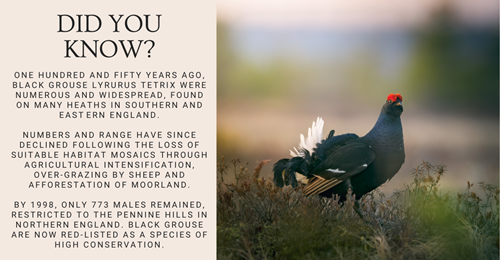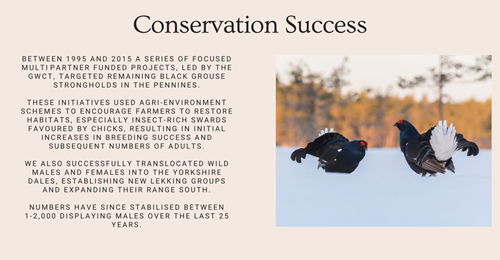Written by Phil Warren for Gamewise Spring 2024
Black grouse in England are now confined to the North Pennines, where low breeding success, habitat fragmentation and landscape configuration means that the remaining population has become increasingly isolated. Climate change in the form of wetter summers and more frequent extreme weather events may further threaten this already small and geographically isolated population.
A new two-year project, with £162,750 funding from Natural England’s Species Recovery Programme, aims to safeguard against potential negative impacts of a changing climate, instigating measures to help increase breeding success, and by expanding the current range into the North York Moors using a conservation translocation technique. We aim to re-establish populations in places where environmental conditions of lower rainfall and warmer temperatures in June may now be more suitable than within their current North Pennines range.

Improving chick survival
In the North Pennines, black grouse chicks hatch in June and require large quantities of insects in the first two to three weeks after hatching to grow fast and survive. Successful foraging and survival appear to be a trade off between the abundance of preferred insects and weather conditions in June when chicks hatch. To gain a greater understanding of brood foraging habitats we aim to fit GPS tags to 15 females. These tags will allow us to determine daily foraging ranges remotely and locate evening roosting locations of breeding females without disturbing them. Within these areas we will sample insect abundance by sweep netting, collect droppings from chick roost piles to quantify chick diet and survival, and take vegetation height, structure, and composition measures.
Collecting these data will allow us to relate brood habitat usage and subsequent brood survival to insect abundance, sward height, structure, and composition. This information will be then used to help inform grazing regimes to create the desired brood-rearing habitats in rough grasslands on the moorland fringe.

Expanding black grouse range into the North York Moors
The second measure to help safeguard against climate change will involve reintroducing black grouse into suitable habitats in the North York Moors. These more easterly, low-altitude sites have markedly lower rainfall than the wet, high-altitude sites in the North Pennines. Here suitable connected habitats on the fringes of grouse moors, where gamekeepers provide protection from predators, have the potential to support at least 100 males.
The nearest black grouse are currently 30-40 kilometres (km) away in the Pennines, separated by an effective barrier of lowland grassland-cereal farmland. Long distance dispersal between the two has been reported by females in recent years but is infrequent and appears restricted by the gap, with females typically dispersing on average 9km up to a maximum 30km, compared with males which only move short distances (<1km). Owing to the isolated nature of the North York Moors we aim to assist range expansion by translocating both males and females into suitable habitats. Birds will be donated from grouse moors in the North Pennines and equipped with radio-transmitters to allow us to follow settlement patterns, survival and lekking behaviour.
Through this project we aim to provide evidence to help guide landscape-scale management of moorland fringe grasslands to benefit black grouse and to increase its range to help mitigate against likely future impacts of climate change.